 By Ray Rivers By Ray Rivers
October 29th, 2016
BURLINGTON, ON
“… we live in a world where we make our own future and the role of government is to facilitate each of us in being the best we can be.”
 Former Prime Minister Kim Campbell – she chose to tell the public what the real issues were – and they booted her out of office. Kim Campbell, shortly after becoming Canada’s first female PM in 1993, announced that it was unlikely the deficit or unemployment would be much reduced before the end of the century. That statement was the first shovel of dirt from the grave she was digging for herself and her party – taking it from its highest poll numbers in decades to a miserable two seats in Parliament. Eventually that election marked the sunset of the Progressive Conservative party.
Canada’s finance minister Bill Morneau, recently told an assembly of Liberal party faithful that high labour turnover and short-term employment contracts are here to stay, and the government should prepare for it. Of course the opposition parties have jumped on that statement as being out of touch with today’s youth, much as Campbell’s comment was out of touch with everyday Canadians hoping to make their lives better.
 You chop here and you chop there – and before you know it that square peg will fit into that round hole. It’s true that the big corporations and the broader public service (including health and education) are the historical providers of that proverbial job for life. Yet today big business makes up only 0.1 percent of all Canadian businesses and they employ only 10 percent of Canada’s non-government sector workforce. We are a nation of small and medium companies, counting some 10 million employees, by contrast. And indeed these enterprises are fraught with volatility, some closing down as quickly as others start up – literally in the thousands every year. So there should be nothing too shocking in what the Finance Minister had to say – it is reality.
Except that judging from the public reaction, we don’t think it is acceptable that today’s high school, college or university graduate should go on to live their lives under the shadow of job insecurity. That is unless they join the broader public service or are one of the lucky one million to land a career in banking, insurance, oil, and auto manufacturing. Otherwise one will have to find employment or create a business opportunity in a small to medium sized business. And that means minimal benefits, and even rarer, a company pension.
And when it comes to pensions, no one knows more than Mr. Morneau, who used to be part of the largest administrator of defined benefit plans (fixed pension) in Canada. And he is also, de facto, the author of the newly augmented Canada Pension Plan (CPP). Eligible benefits under the new plan will bring the CPP up to a third of one’s former salary. And Morneau understands that the day of company defined benefit pensions are numbered and that the CPP will be expected to play even a greater role in our lives.
 And this is what might be left when all is said and done. Morneau talked about the need for government to support training and retraining programs. But didn’t mention the need to reform the current EI program. If steady employment for most Canadians is a thing of the past, isn’t it time to send the old complicated EI into the dustbin of history, and to replace it with a national guaranteed annual income? An economy where people make their career choices based on maximizing their potential rather than economic desperation can only lead to greater productivity.
Kim Campbell was just trying to be honest and frank with Canadians when she told them to suck it up. But she underestimated Canadians ability to do better, looking into the distance using her reading glasses. Indeed the Chretien government slew both the deficit and high unemployment beyond her expectations. And she paid a big price and learned a big lesson for speaking her mind.
Kim Campbell has, in fact, lived the kind of career that Morneau could have been talking about. University lecturer, politician, diplomat, lawyer and writer, lawyer, diplomat and more. In addition to being Canada’s first female PM, she was the first from B.C., and the first baby boomer to take that office. And if we remember her for nothing else it should be how she effectively brought an end to the endless debate on abortion in this country, something our American neighbours must envy.
She has appeared on talk shows (Bill Maher), sounding more like a Liberal than from the party on the right which rose from the ashes of her failed election campaign. And indeed, the Trudeau government made her the chairperson for the new Supreme Court Advisory Board, leading the transparent process which has just seen our latest appointment to the highest bench in the land.
Not everybody will be fortunate enough to have that kind of resume when they hit 70, which Campbell will be doing next year. But we live in a world where we make our own future and the role of government is to facilitate each of us in being the best we can be.
So yes, Mr. Morneau, it’s federal support for training and education. But it’s also additional tax reform to favour the middle class. And if we are really serious, about this issue, it’s time to implement Canada’s first guaranteed annual income. Then those young people protesting their lot in life will have only themselves to blame.
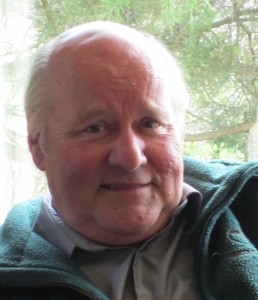
Ray Rivers is an economist and author who writes weekly on federal and provincial issues, applying his 25 years of involvement with federal and provincial ministries. Rivers’ involvement in city matters led to his appointment as founding chair of Burlington’s Sustainable Development Committee. He was also a candidate in a past provincial election
Background links:
Kim Campbell – Canadian Business –
Chinese Investments –
Morneau –
More Morneau –
Morneau on Pensions –
Millenials –
Trudeau Heckled –
Trudeau Protests –
Guaranteed Annual Income –

 By Pepper Parr By Pepper Parr
October 28, 2016
BURLINGTON, ON
Burlington parents with students in Central high and Lester B. Pearson high school are scrambling. The Halton District School Board (HDSB) put a series of recommendations before the trustees earlier this month that could result in the closing of the two high schools.
The Board of education is driven by provincial funding rules that require them to do a Program Accommodation Review (PAR) if the percentage of the seats available in a school that are being used falls below 65%
Central high and Pearson are at that level.
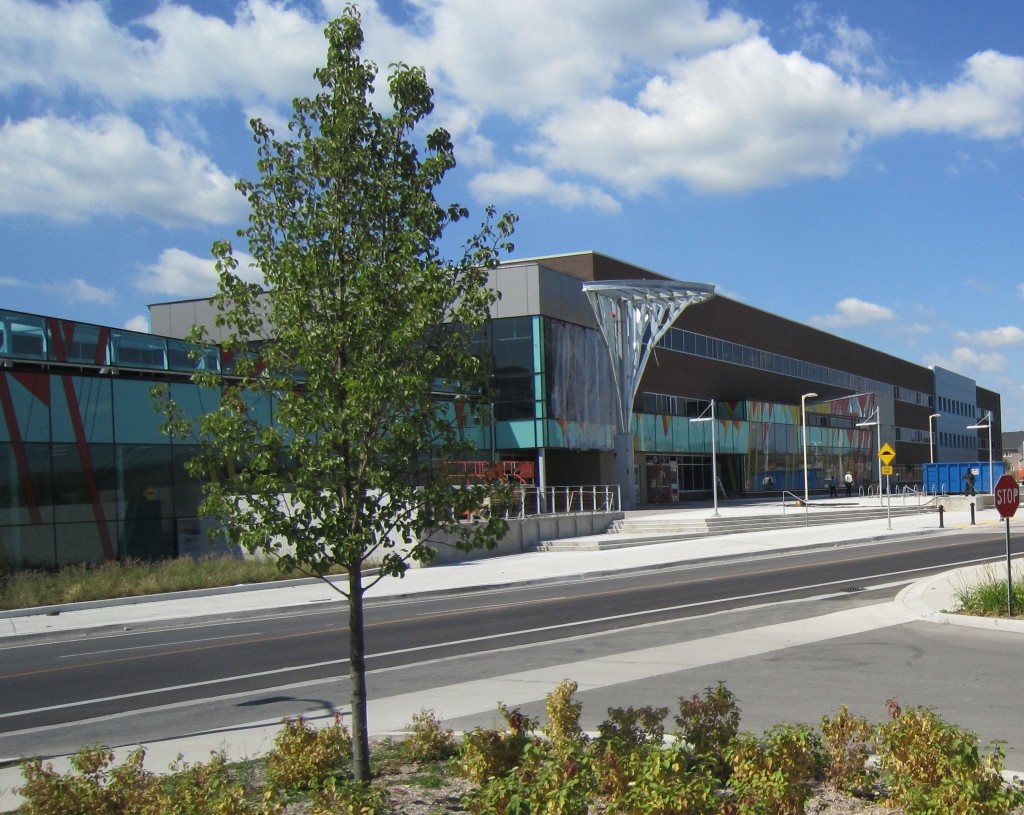 Hayden High school, Burlington’s newest built as part of a complex that includes a Recreational Centre and a public library with a skate park across the street is at 115% capacity and already has portables in the parking lot. The Board situation is complicated in that the three year old Hayden high school is at 115% capacity.
Director of Education Stuart Miller explained to the trustees that the city has one and a half too many high schools – and that they are south of the QEW where the student population is falling.
The process of closing a school requires that a Program Accommodation Review Committee (PARC) be formed and that the trustees listen to what that committee recommends before making a decision.
The PARC process is to be completed by May of 2017. That is a tight timeline.
There are people in the academic world who think the province is forcing the school boards to do this the wrong way – and that opting for larger school rather than smaller school is bad pedagogy.
Schools play a central role in their communities. They are essential to economic development and they make communities more attractive to new- comers. Businesses are more likely to move to communities with schools, and families will not move to communities without schools. When a community loses its school, it loses its viability.
Extensive research over the last decade shows that small schools make excellent learning environments for students, and that, despite economies of scale, they are often cost effective because of their higher graduation rates.
Creative and proactive strategies must be developed now to recognise the value of small schools and to ensure their viability and that of their communities.
Bill Irwin of Huron University College and Mark Seasons at the University of Waterloo school of Planning argue that the push to close school doors seems to be an economic exercise, overlooking educational and community needs. Irwin is a professor of Economics and Management and Organizational Studies at Huron.
Together they have launched a website: env-blogs.uwaterloo.ca/schoolclosures/ offering a research-based platform to guide discussion about school closures.
“We believe,” the website states, “that the theory and best practices of both urban planning and public participation are good foundations from which to ameliorate the school closure process, and ultimately lead to a more effective and equitable outcome for those involved.”
The website is one of the outcomes of a 2013-14 Social Sciences and Humanities Research Council (SSHRC) Insight Development Grant.
“We’re looking at the whole issue surrounding school closures, in terms of several touchstones – as a public policy issue, and how policy is developed and delivered; as a public participation issue and the relationship between institutions and communities; and the implications of closures in terms of impacts on financial, social and human capital,” Irwin explained.
There are a number of factors driving this school closing trend.
• The last of the baby-boom generation’s children (who have created an enrollment swell since the 1970s) are now completing their secondary education.
• Ontario’s secondary school curriculum was reduced from five years to four years resulting in the loss of a whole grade of students.
• With the growing industrialization of agriculture, the loss of Ontario’s family farms has added to the exodus from rural areas.
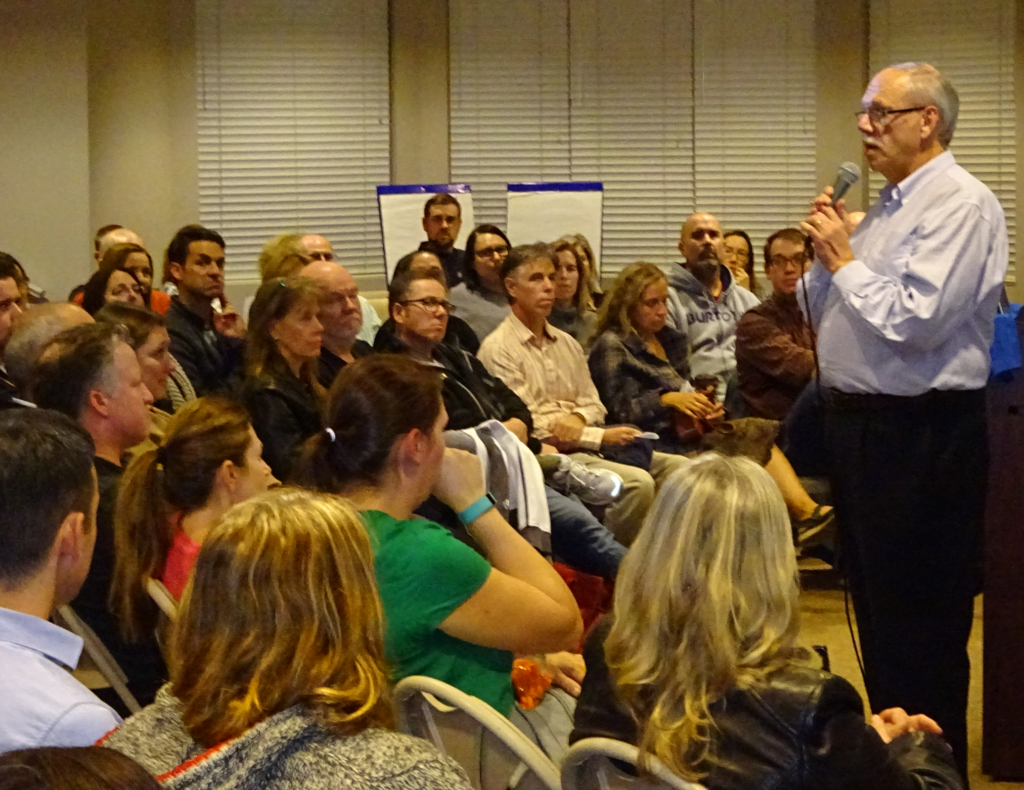 Terry Ruff, a former Central his school principal explained to parents how a possible closure was avoided when he was principal in 2000. “The research into the subject of school closures is grounded in developing and implementing a better decision making process with regards to accommodation review. To complement this, the researchers are concentrating on three areas of focus; public participation, urban planning, and the accommodation review process itself. We believe that the theory and best practices of both urban planning and public participation are good foundations from which to ameliorate the school closure process, and ultimately lead to a more effective and equitable outcome for those involved.
 The Simms building, directly across the street from city hall is a number of city departments – Legal and Human Resources. Might they take up some of the spare space at Central ? “One of the key components to realizing this objective is the ability to achieve an increased awareness of this issue, and to encourage an informed discussion between government officials, policy makers, school board administrators, and civic leaders alike. To support this, the researchers have provided material that they believe will enable a wide range of stakeholders to become better informed about the various guiding aspects of accommodation review and school closures.”
A major problem the closing of a school stumbles upon is that planning is a municipal function – and in Burlington the Board of Education and city hall tend not to work very closely together; the two don’t have an organizational structure they can meet on as equals.
The last time there was an educational issue that involved the city was when the Charles Beaudoin School wanted to add more portables – but in order to do so they had to get permits from the city.
The parents at the school didn’t want more in the way of portables so they pressured the city not to give the Board of Education what they said they needed.
The school board eventually got permission to install additional portables – just not as many as they needed.
“There is documentation that will enable others to become better informed about some of the more subtle elements and underlying causations that have led school closures to become such a highly contentious and polarizing experience.
 The parents at Central high are well organized – Pearson is trying to catch up. “School closure decision making process have been framed by policy makers in Ontario, through the accommodation review process (ARCs) (2006), as exercised in public participation. Critics of ARCs have decried the process being more of a subterfuge than a genuine attempt of joint institutional-community review. At its core, the research is a quest to better understand the relationship between institutions of education, in Ontario represented by the provincial Ministry of Education and local school boards, and the community.
“Furthering this understanding will require addressing the question: How do people view the concrete and practical application of school closure policy in their community? Critics of the current ARC process in Ontario have stated that the provincial government appears to ne be making use of school boards to regulate the citizenry to their own end, applying the version of the Foucauldain (a form of discourse analysis, focusing on power relationships in society as expressed through language and practices) notion of governmentality.
“The questions are: How does the community view the consequences of school closings, especially as the closing occur in local settings? How does (or do) the end results of school closings reflect what community members’ desire? or the process of review?
“The research starts with the premise that ‘true public participation’ in any policy decision rests not only with the institution listening to the community; the institution needs also to consciously include the community insights into the final outcome. Therefore institutional context and motive plays a pivotal role in determining a group or individual’s capacity to make informed choices, and then transform those choices into desired actions and outcomes. Capturing that institutional context and motivation as it relates to public participation, actual and perceived, is a major focus of the research.”
Bill Irwin explains: “When I started my research – my thesis (in 2012) was on school closures – no one else had looked at this issue since the policy had come forward in 2005,” he continued, adding if the province was closing smaller community schools as a fiscal savings measure, there was no tracking of those savings. More importantly, there was no review of community costs.
“How does a closure impact students as learners? We don’t know if this is impacting students’ ability to learn or their marks. This happens in young people’s lives at the same time they’re going through emotional, physical changes. There are so many unanswered questions in this,” Irwin continued.
“The Ministry of Municipal Affairs and Housing is spending resources on rebuilding houses, while the Ministry of Education is supporting closures of community schools. We want to rebuild our inner cities, yet we want to shut down schools in their communities,” Irwin said.
“We’re taking schools from poor neighbourhoods and putting them in affluent neighbourhoods. It’s a reverse Robin Hood situation.”
“What’s more, current policies surrounding school closures ignore previous research that shows smaller schools have a great impact within their communities.
“In the 1960s, 70s and 80s, robust research literature was done on the benefits of small schools as learning environments, as having long term benefits to students. That literature has been totally ignored in this whole process,” Irwin said.
“All of us realize there will be a provincial election this year. This should be part of the discussion. How we treat our schools has a tremendous impact long-term on the social fabric of our communities,” Irwin said.
• The number of small elementary schools with full-time principals has dropped by 15%, twice the rate of the drop in all elementary schools in the province.
• The number of small elementary schools with a teacher-librarian (full- or part-time) has declined by 53% compared to a 30% decline in all elementary schools.
• Just 20% of small elementary schools have access to a physical educa- tion teacher, compared to 51% of larger elementary schools.*
• Only 25% of small elementary schools have access to specialist music teachers, compared to 61% of larger elementary schools.
• All larger secondary schools have libraries that are open full-time, but 21% of small secondary schools had libraries open only part-time.
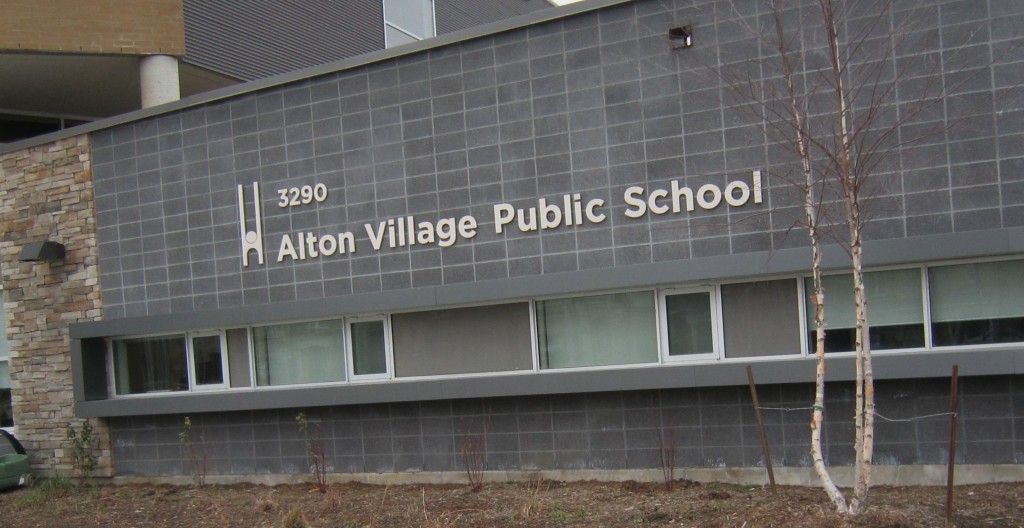 The Alton public school is scheduled to have a second floor added – the school hasn’t been open three years. Three quarters of Ontario’s small elementary schools and 83% of small high schools report that their schools are used by the community after school hours for everything from sporting events to ratepayers’ meetings.
Ontario’s drive to build larger schools is solely a response to an education funding formula geared to larger schools – it is an economic decision rather than a pedagogical one.
The HDSB recently approved taking on commercial enterprises that could use some of the space; meetings were held but nothing has come of this kind of opportunity so far.
The city of Burlington has been renting space in the Sims Building directly across from city hall for years. There is a consultant’s report in a filing cabinet gathering dust that sets out what the city is going to need in terms of office space and what is currently has – that report has not been released to the public yet.
After years of stopgap solutions, it is time to reverse the trend and recognize that closing a school is not simply an educational issue, it has major social and demographic repercussions as well.
The researchers declare that “we must recognize the reality of declining enrollment in Ontario, and come up with new and proactive solutions to maintain the viability of small schools and communities. It is time to develop creative ways to keep the school buildings vital and expand their role as the hub of their communities. We can take cues from other places: English small schools are inviting postal sub-stations to occupy a part of their buildings; Newfoundland has community schools that have on-site social service agencies, community radio stations, and seniors’ programs. It is possible to modify school buildings slightly so that they can function as community centres as well, and, if provided with adequate funding, day care centres enhance schools and act as a draw for young parents.”
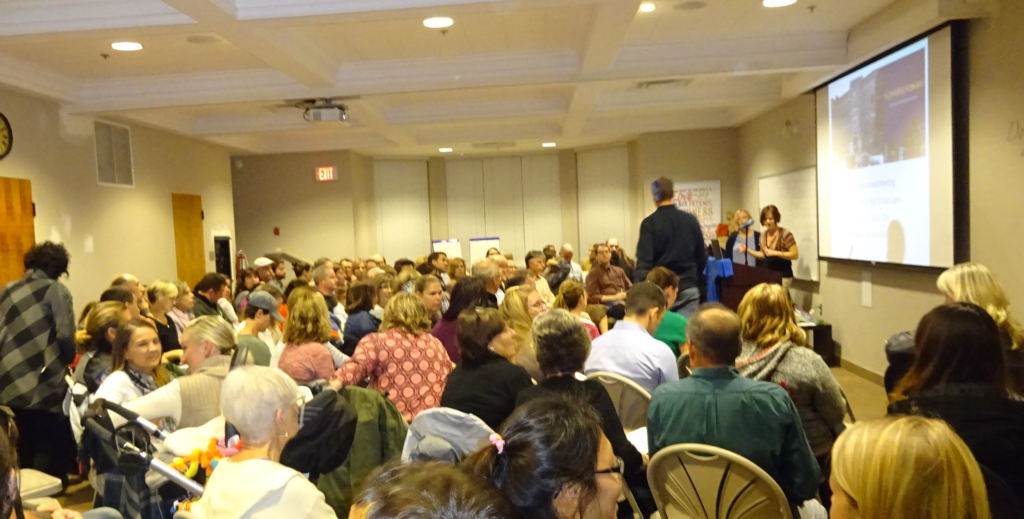 Expect to see a lot more evening with rooms packed with parents as the |Board of Education begins a series of meeting to explain the PAR process. There will not be a Q&A session at any of these meetings. Somewhere in the research there is mention of adjusting transportation guidelines and funding to ensure that no student spends more than 1½ hours per day on the school bus. That amount of time suggests students in Burlington are being prepped for commutes on the QEW,
The battle in front of the parents right now is the very real threat to two of the city’s high schools – there might be a higher level discussion these parents can put in front of the trustees and that is – what size of schools do we want and can we slow things down a bit and take the time needed to get this right the first time.
This article draws heavily on the work of Bill Irwin at Huron University College and Mark Seasons at the University of Waterloo. 

 By Staff By Staff
October 27, 2106
BURLINGTON, ON
The Region of Halton council is going to grow by three members – none of those new members will come from Burlington.
Milton will get two more members and Oakville will get a single additional member.
Burlington and Halton Hills will remain as they are with 7 members from Burlington and xx members from Halton Hills.
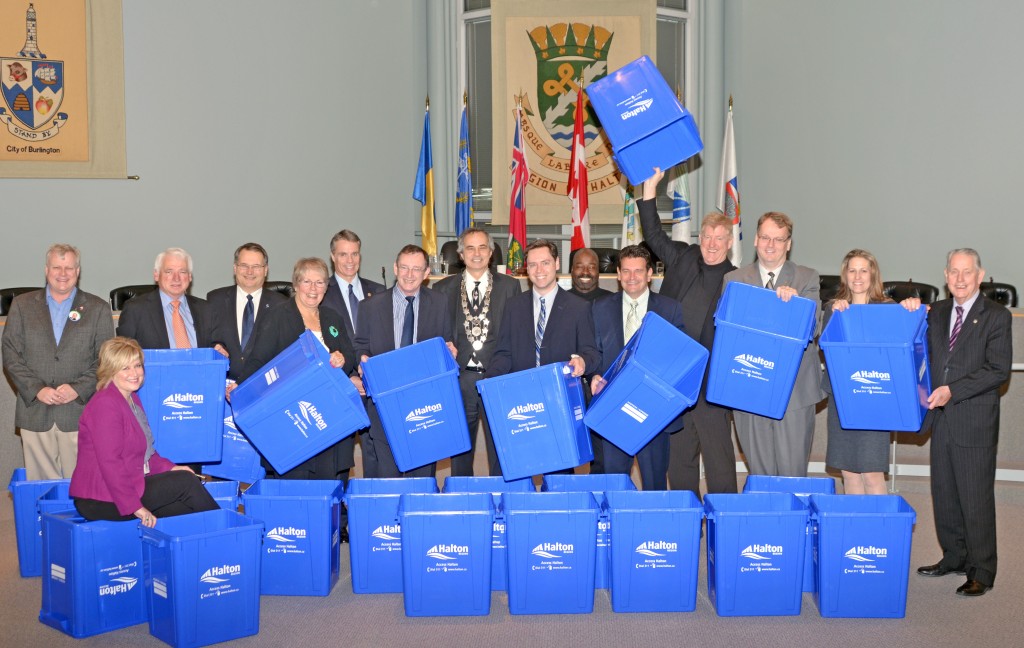 Regional Council will grow by three additional members. What this means is that Burlington’s influence at the Regional level will fade – not that it has ever been that strong at any point in the recent past.
Burlington’s representation seldom votes as a block – each Council member tends to go their own way with their own views as to what is best for Burlington.
Members of Burlington’s city council earn half of their approximately $125,000 (give or take a bit) from the Regional government and the other half from the city of Burlington.
On June 13, 2016 an Ontario Regulation (196/16) was enacted to permit Halton Region to increase the size and composition of Regional Council by adding two Councillors from the Town of Milton and one Councillor from the Town of Oakville.
In accordance with the Municipal Act, Halton held the required public meeting on September 7, 2016. No submissions or comments regarding the by-law were received. Regional Council passed the required by-law on September 14, 2016.
The by-law is not valid until the following conditions have been met:
• A majority of all votes on Regional Council must be cast in favour (achieved);
• A majority of the lower tier Councils must pass resolutions consenting to the by-law; and
• The total number of electors in the lower tier municipalities that have passed resolutions consenting to the by-law must form a majority of all electors in the Region.
This item didn’t get any discussion at the Burlington City Council meeting October 10th
.

 By Pepper Parr By Pepper Parr
October 28th, 2106
BURLINGTON, ON
The developer of the application for the proposed 26-storey condominium at 374 and 380 Martha St., Adi Development Group, has requested, through its legal counsel, that the City of Burlington participate with Adi in an Ontario Municipal Board-led mediation process in an effort address the city’s issues with the revised development applications in advance of the scheduled hearing on Feb. 21, 2017.
 Most recent architectural rendering of the Nautique development planned for the intersection of Martha Street and Lakeshore Road. The city is prepared to engage with Adi in an OMB-led mediation. The mediation is not binding.
Mediation calls for an open, honest and respectful exchange of views – difficult to see that happening when Adi president Tariq Adi is reported to have said the Mayor’s comments were “laughable”.
Mediation is not normal in Ontario Municipal Board (OMB) hearings. Recall that these hearings were asked for by Adi when the city did not respond to their Official Plan and by law change request that were part of the application they made back in 2015.
When the city and Adi eventually got in front of an OMB officer ADI asked for an adjournment because they had acquired an additional piece of land which they argued at the time would allow them to come back with a revised plan.
Which they did – that revised plan added 48 units to the development proposal – it at the same time lopped two floors off the structure – from 28 down to 26.
Adi is spending a significant amount on advertising and marketing the development – one could venture a guess that they are so far extended on this development that they have to find a way to recover their losses.
Mediation would be interesting – unfortunately those sessions will be behind closed doors – will the city fold on this when the public can’t see what they are negotiating?
The city’s Planning department spend days “negotiating” with Adi – it went nowhere.
Should the OMB officer go along with mediation – what that does is give Adi another tool with which to beat down the city should the mediator find that some of the Adi suggestions had merit but the city found it was more than they wanted to go along with.
Better methinks to have everything done before the OMB hearing which is public.
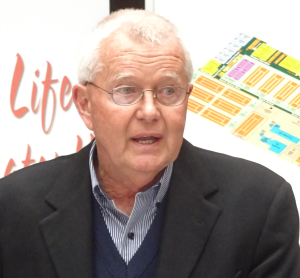 Councillor Jack Dennison We know where Councillor Dennis stands on this one. He likes the 19 storeys at Lakeshore and Torrance. The Mayor is prepared to mediate – with a guy that says his position is laughable.
“I support mediation because I believe it gives the city an opportunity to influence a positive outcome for this development. We do not know if mediation will be successful, but it is worth attempting before we proceed to the hearing. I continue to seek a development proposal for this site that is respectful of the surrounding area and streets, and integrates well with the existing and planned context of the area.”
 Adi brothers Saud and Tariq Naïve would have been a more appropriate word.
Adi has been jerking the city around for the past couple of years. They took this to the OMB – let it get resolved at that level.
Salt with Pepper is an opinion column.


Pretty sure this is a first for high school students – a letter from the Director of Education explaining the possibility that their high school might close. Interesting decision.
October 27, 2016
Open letter to all Burlington high school students
Dear Students,
As you have no doubt heard, the Board of Trustees of the Halton District School Board voted last week to begin a process to look at student accommodation issues in our Burlington high schools. The process is called a Program Accommodation Review or PAR. I am writing to explain a bit about this process, but more importantly, to let you know that your input will be important in this process.
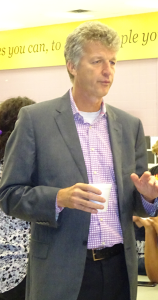 Why do we need a “PAR” process? Why do we need a “PAR” process?
The Halton District School Board has initiated the Program Accommodation Review because we have schools with declining enrollment. As the Director of Education, I have a responsibility to provide excellent programs and environments for learning. I need to ensure all secondary school students in our Board have access to the best possible education we can deliver.
According to the Board’s Program Accommodation Review policy, the Director’s Preliminary Report must include a staff recommended option. This recommendation is not a final decision, but a starting point for consultation in this PAR. Staff has recommended Option 19 which proposes various boundary and program changes across Burlington secondary schools, as well as the closure of Lester B. Pearson High School and Burlington Central High School.
The PAR process will begin in November with information sessions held at each Burlington high school. You are welcome to attend these sessions and learn more about this process and help you formulate your own opinions. These evening meetings are on November 1, 3, 14 and 15. Refer to the HDSB website at www.hdsb.ca for more details. If you are unable to attend, the presentation will be posted on the Board’s website.
On November 21 at 7 p.m., Board staff will join me in hosting a live online question and answer session. Log on at www.hdsb.ca . Your questions are most welcome.
The Board of Trustees will make their decision in May 2017; however the earliest date that any changes could take place is September 2018.
As high school students your opinion is valued. The decisions made by the PAR committee will profoundly impact your school experience and those who follow you. In the New Year, the PAR committee will gather feedback from Burlington high school students. We want to hear your voice!
As a parent and educator I understand many of you are deeply loyal to your school, your teachers, and the school traditions that have developed over many years.
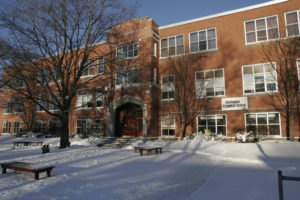 However, as the Director of Education, I need to ensure all Burlington high school students have equitable access to programs that allow them to explore and enhance their true potential. The PAR process will look at this issue and investigate various options to address the challenge that many Burlington high school students are experiencing. However, as the Director of Education, I need to ensure all Burlington high school students have equitable access to programs that allow them to explore and enhance their true potential. The PAR process will look at this issue and investigate various options to address the challenge that many Burlington high school students are experiencing.
I encourage you to stay informed and engaged in the PAR process. We will keep you informed through ongoing information posted on our website at www.hdsb.ca
We will provide more details about how you can share your input in the New Year.
Sincerely,
Stuart Miller, Director of Education, Halton District School Board

 By Staff By Staff
October 27th, 2016
BURLINGTON, ON
Thus is one of those event you want to order your ticket for now – they do go quickly.
The Art Gallery has been putting on this event for 20 years – this is the 20th anniversary of an event that has become a favourite fall fundraising event!
 Hundreds of hand made bowls await the guests who take part in the annual Soup Bowl lunch at the Art Gallery The event brings together hundreds of people to select a handmade ceramic bowl and pair it with a gourmet soup from a local restaurant, all for a great cause. Last year we welcomed 900 guests and raised over $30,000
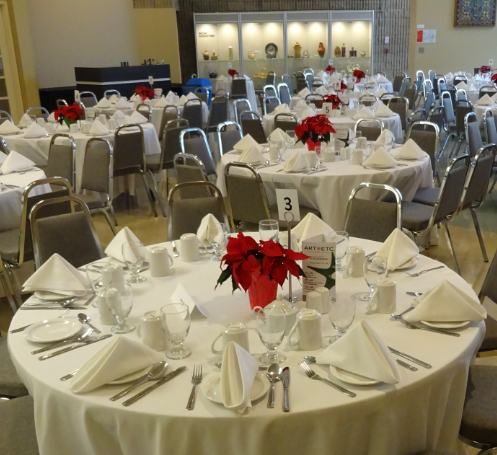 The set up is very tastefully done – the room sparkles. They do up the space nicely for a lunch that is a bowl of soup.
The funds raised support children’s programming, including Open Studio (a free drop in art centre for kids), diversified program offerings, and financial assistance for youth.
Thursday Nov 24 Lunch – 12pm
Very limited tickets available – call us at 905-632-7796 to purchase
Friday Nov 25 Lunch – 12pm
Very limited tickets available – call us at 905-632-7796 to purchase
Saturday Nov 26 Lunch – 12pm
Individual Tickets: $40 AGB Member, $50 Non-member
Tables of 8: $300 AGB Member, $375 Non-Member
Sunday Nov 27 Lunch – 12pm
Individual Tickets: $40 AGB Member, $50 Non-Member
Tables of 8: $300 AGB Member, $375 Non-Member

 By Pepper Parr By Pepper Parr
October 27, 2106
BURLINGTON, ON
This is really a Georgetown story – but there is a lesson for all of us in this one. We are expected to take care of each other.
On October 5th, 2016 Halton Region Paramedic Services were summoned to a Georgetown address by Community Care and Access Centre staff to assess a 91 year old female client requiring medical assistance. The female patient was subsequently transported to Georgetown Hospital.
It was determined that the victim was suffering from the ill effects of not receiving proper care. She was malnourished, weak, unkempt and had been residing in soiled linens and clothing. Halton Regional Police Services were contacted and the One District Criminal Investigations Bureau conducted an investigation.
As a result, on October 25th, 2016 a 63 year old man from Georgetown was arrested and charged with failing to provide the necessities of life.
 “The elderly victim was found living in deplorable conditions. This was an excellent example of team work and collaboration between the internal resources of the police service and external partners. The Halton Regional Police Community Mobilization Bureau and Criminal Investigations Bureau, Seniors Liaison Team along with Halton Paramedic Services and the Community Care Access Centre worked together in bringing this investigation to a successful conclusion,” said Detective Sergeant Dave Costantini. “More importantly, because of this collaboration a vulnerable member of our community has been rescued from unthinkable conditions and I am happy to report she is expected to make a full recovery.” “The elderly victim was found living in deplorable conditions. This was an excellent example of team work and collaboration between the internal resources of the police service and external partners. The Halton Regional Police Community Mobilization Bureau and Criminal Investigations Bureau, Seniors Liaison Team along with Halton Paramedic Services and the Community Care Access Centre worked together in bringing this investigation to a successful conclusion,” said Detective Sergeant Dave Costantini. “More importantly, because of this collaboration a vulnerable member of our community has been rescued from unthinkable conditions and I am happy to report she is expected to make a full recovery.”
Section 215 of the Criminal Code of Canada says it is an offence if an individual fails to provide necessaries of life to a person under his or her charge. Specifically subsection (C)(i) states, “if that person is unable, by reason of detention, age, illness, mental disorder or other cause, to withdraw himself from that charge.”
Detective Sergeant Costantini summarized; “This means it is a criminal offence if you do not provide the necessary care to someone that is in your care and that cannot leave your care due to their age, illness or other cause. The necessaries of life refer to those things necessary to preserve life, such as food, shelter, medical attention and protection from harm.”
Anyone who may have information that would assist investigators in this case are encouraged to contact D/C Sarah McCullagh – Seniors Liaison Investigator at 905-78-5511 ext: 2419 or Crime Stoppers at 1-800-222-8477 (TIPS), or through the web at www.haltoncrimestoppers.com, or by texting “Tip201” with your message to 274637 (crimes).

 By Pepper Parr By Pepper Parr
October 27, 2016
BURLINGTON, ON
 A safe, secure, confidential place to call with information that will keep our streets safe. Everyone knows what Crime Stoppers is – we see their logo and sort of understand what they do. But has anyone told you the amazing story about how the organization got started – and the fundamental principle behind what Crime Stoppers is all about?
Greg MacAleese, who had just become a detective with the Albuquerque Police Department’s (APD) violent crimes unit, sat down during one of his shifts and started typing up some of his random thoughts. “I started focusing on why we have so much unsolved crime,” he said. “I realized it’s citizens who control the crime rate in any city. We don’t. We just react to it and most crime is solved with their help.”
Think about that – it is the citizens who control the crime rate – the police use the information they get to react to a crime.
MacAleese said eventually he wrote something along the lines of “Why don’t people come forward with information they have about crimes?”
The next logical question, he said, was how we get people to help us solve more crimes.
“They were afraid of retaliation or becoming a target of that criminal,” he said. “I thought if we allow them to remain anonymous they could tell us what they knew.”
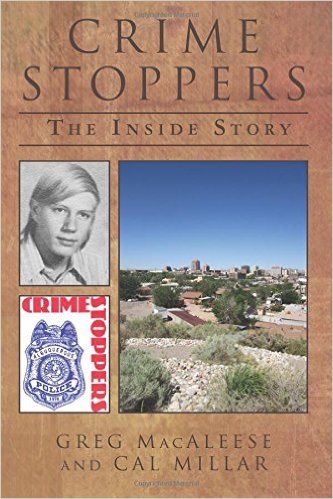 Fingerprinting, DNA and Crime Stoppers are descried as the three most useful tools police have going for them. And so was the beginning of Crime Stoppers, which now exists in every major city in the United States, Canada and countless countries around the world.
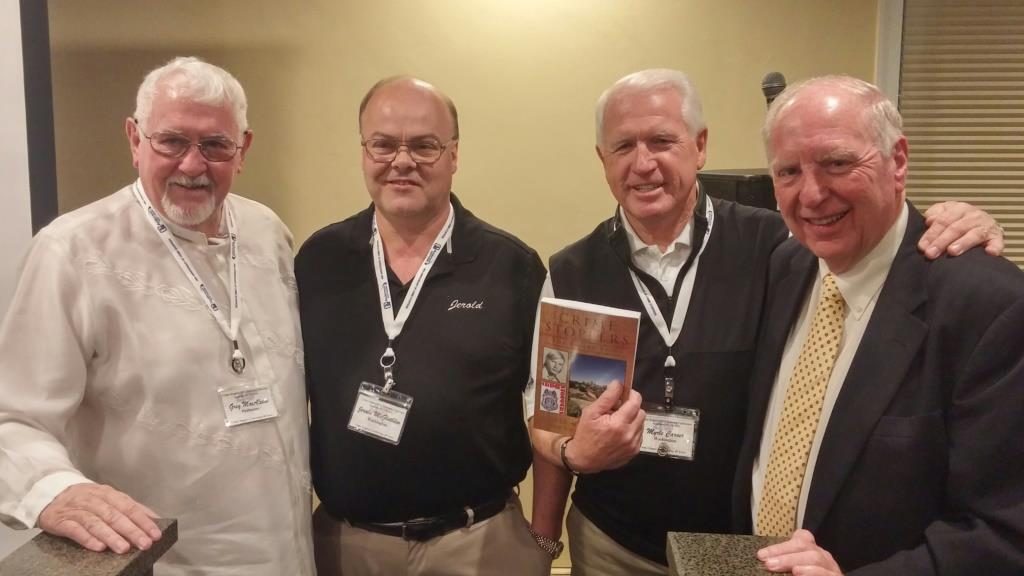 Greg MacAleese, Jerold McGlothin, Myrle Carner and Cal Millar at 40th Crime Stoppers anniversary banquet in Albuquerque. MacAleese recently published a book, co-written by Cal Millar, a former reporter and founding member of Toronto Crime Stoppers and a well know Burlington resident.
“Crime Stoppers: The Inside Story,” celebrates the 40th anniversary of the program by exploring crimes APD solved with Crime Stopper tips. The book is available on Amazon.
The program has become an irreplaceable tool in solving crimes for law enforcement officers and according to the book, a major crime is solved every 14 minutes because of Crime Stoppers tips. Police have recovered $2 billion in stolen property, seized $10 billion worth of drugs, and made more than a million arrests.
MacAleese realized there was a lot of apathy and said: “I knew money talked out on the street so I wanted to include a reward.”
An independent board of citizens was created to raise money for the rewards. MacAleese said initially he received some resistance from the APD with one of his superiors questioning why people should be paid to do their civic duty.
“I told him ‘You have a point,’” he said. ”But the fact is they aren’t.’”
The third and final component of the program, he said, was partnering with local newspapers and television stations to pass along information about unsolved crimes to the public.
Jim Busse was a Captain with APD when MacAleese started floating around the idea of the program. He said Albuquerque was still a “sleepy little town” in many ways but had its share of big-city crime. He said there was some cynicism about the program but that all disappeared when crimes started getting solved.
The idea took off very quickly,” he said. “Not everybody believed it would work. We had seen many programs come and go only to be reinstated with a new administration.”
A crime in July 1976 would give MacAleese the opportunity to launch his program and test its merit. Michael Carmen was a 20-year-old college student working at a gas station in the Southeast Heights in the early morning hours of July 25.
 Michael Carmen, a 20-year-old college student was murdered – that crime was the first crime to be solved through a Crime Stoppers tip. Armed robbers shot Carmen at close range with a .12-gauge shotgun. MacAleese believed they were worried that Carmen could identify them so he was killed to be eliminated as a witness.
Initially the police had no leads. The department put together a re-enactment of the crime that KOAT television broadcast on Sept. 8, 1976. The clip included a hotline number with a promise that all tipsters would stay anonymous.
“The phone started ringing immediately,” he said. “The second call was about a gang rape that happened a month before that we hadn’t been able to solve.”
The caller turned out to be a relative of one of the offenders and the information he gave led to the arrest of the three assailants, who had offered the young woman a ride after her car broke down in Downtown Albuquerque, New Mexico.
The sixth call, MacAleese said, broke open the Carmen case. A man who happened to live in the area said he recognized the car used in the crime and it belonged to a man in the neighborhood. MacAleese asked him to call back with an address.
A few hours later he did and after some surveillance police arrested Thomas Charles Boone and Lawrence Edward Tate. Boone was acquitted but Tate was found guilty and sentenced to prison for killing Carmen.
MacAleese, 69, now lives in the Cagayan de Oro in the Philippines, where he is an associate pastor. A widower, he traveled there years ago and met the woman who would become his second wife. They have two sons, 5 and 7 years old.
“What happened when my wife told me she was pregnant is that I realized it was a tremendous blessing,” he said. “I made a deal with God, even though that’s not what you are supposed to do, and I said ‘If you provide me with a healthy baby, I’m yours.’”
His first son was healthy and MacAleese dedicated himself to helping others by becoming a pastor.
APD, he said, solved almost 300 crimes the first year with the help of Crime Stoppers tipsters. Word spread and other police departments across the state and the country started establishing similar programs.
“You know we had success instantly,” he said. “They (other officers) would joke about my Crime Stoppers program but after that first broadcast, the guys started coming forward to me with their unsolved cases.”
 Cal Millar wrote a book of his own about Crime Stoppers. He has been very active with the organization in Halton Region. The Halton Chapter of Crime Stoppers gets about 100 tips each month. Of those, 20 are instrumental in solving local crime.
MacAleese was right: it is the citizens who control the crime rate – the police work with what they get from the people they are there to protect.
Cal Millar is part of that group that keeps the Crime Stoppers concept alive – because it works.

 By Staff By Staff
October 26, 2016
BURLINGTON, ON
Do you remember the day you first went to school? It was certainly a different time – we live in a different world.
To start with there are no longer rows of desks.
The Halton District School Board wants to make that transition as smooth as possible. In November and December, future students and their parents/guardians are invited to attend one of five Kindergarten Open Houses to learn more about starting school.
 The years in school will probably be longer than the time they spend in any one job. Drop by any one of the following open houses between 6:30 to 7:30 pm.
Georgetown:
Thursday, Nov. 3 – Ethel Gardiner Public School (14365 Danby Road)
Burlington:
Thursday, Nov. 10 – Bruce T. Lindley Public School (2510 Cavendish Dr.)
Milton:
Thursday, Nov. 17 – Tiger Jeet Singh Public School (650 Yates Dr)
Acton:
Tuesday, Nov. 22 – Robert Little Public School (41 School Ln)
Oakville:
Thursday, Dec. 1 – West Oak Public School (2071 Fourth Line)
At the Open House, students and parents will:
• Explore a Kindergarten classroom
• Learn about play-based learning
• Pick up information and resource material in a free backpack
• Access information about community agencies and resources in Halton
• Get information about before and after school care
• Connect with special education staff to discuss any developmental concerns
Children born in 2013 can start Kindergarten in September 2017.
Registration for Kindergarten begins in January 2017 and takes place at the school your child will attend.
View our video to see what you will learn about the Board’s Kindergarten program.

 By Staff By Staff
October 25th, 2016
BURLINGTON, ON
They are known as the Invasive Shrub Removal Volunteers Thy have been gathering every Saturday since mid-October at the Nature Interpretive Centre on the north side of Cootes Paradise, RBG Arboretum 16 Old Guelph Road, Hamilton ON.
There efforts come to an end November 19th, 2016, 9am to 1pm. RBG staff will provide you with a parking pass for the day*
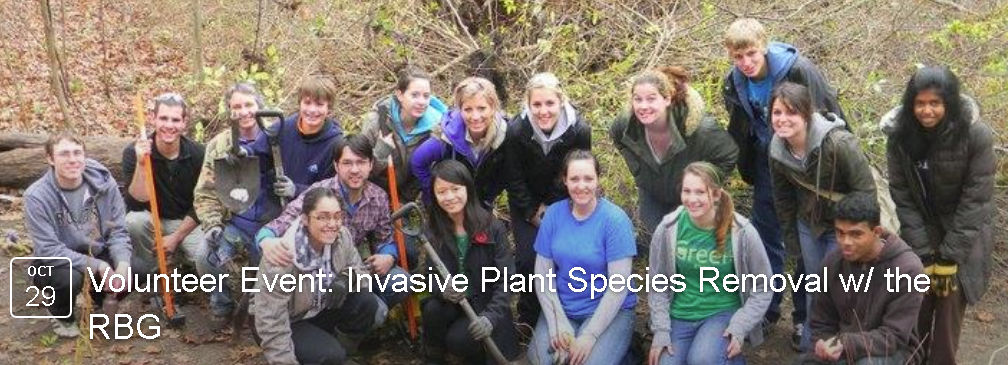 Royal Botanical Gardens’ Nature Sanctuaries protect over 900 hectares of woodlands and wetlands. They are an important stopover for migratory birds and a biodiversity hotspot. The health and sustainability of our Nature Sanctuaries is being threatened by non-native, invasive species. Royal Botanical Gardens’ Nature Sanctuaries protect over 900 hectares of woodlands and wetlands. They are an important stopover for migratory birds and a biodiversity hotspot. The health and sustainability of our Nature Sanctuaries is being threatened by non-native, invasive species.
YOU can help RBG’s Natural Lands staff preserve biodiversity by participating in our invasive species removal volunteer events. Volunteers will protect our important interior forest ecosystems by extracting and destroying non-native invasive shrubs.
Remember – Dress for the weather and be prepared to get dirty. Please wear closed toed shoes, and bring a portable lunch and water bottle. The RBG will provide water, apple cider, snacks and all of the equipment and training required.
NOTE: Volunteers under the age of 18 must have a parent/guardian sign a volunteer waiver
To RSVP please visit the link to the RBG website below or call 905-527-1158 x257
Cancelations due to inclement weather will be posted on RBG’s Facebook page and tweeted (@RBGCanada).

 By Staff By Staff
October 25, 2016
BURLINGTON, ON
Hurd Avenue will be closed at Birch Avenue on Wednesday, Oct. 26
7 a.m. to 5 p.m.
The intersection will be closed to install a new sanitary sewer.

 By Staff By Staff
October 25, 2016
BURLINGTON, ON
It was a quickie – took less than ten minutes that included a recorded vote.
City Council voted for the recommendation that came out of the Development and Infrastructure Standing Committee to not Approve the revised application the ADI Development Group put before the city last June.
This was the final step the city is able to take now that the matter is fully in the hands of the Ontario Municipal Board.
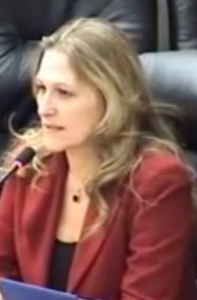 Ward 2 Councillor Marianne Meed Ward said the proposed ADI Development group plans for the intersection of Martha Street and Lakeshore Road was over-development of the property and should not be permitted. The only person to speak to the motion was Councillor Marianne Meed Ward who said the proposal was an over-development of the site. She added that something would be built on the property but that “this wasn’t it”.
Councillors Sharman and Dennison did not attend the council meeting.
Whatever gets built on the property at the intersection of Martha Street and Lakeshore Road is now in the hands of the Ontario Municipal Board.
That Board is scheduled to meet on Thursday and Friday of this week for a pre-meeting that will clarify just what is going to be heard at the hearing scheduled for February of 2017
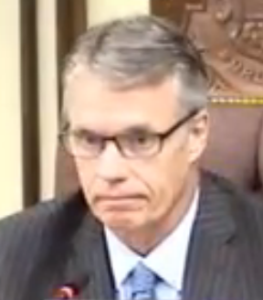 Mayor Rick Goldring during the Monday Special Council meeting. The motion voted on yesterday was to endorse the staff recommendation to oppose amendments to the Official Plan and Zoning By-law that would be required to permit the revised development proposal as outlined in this report for 374 and 380 Martha Street; and
Direct the City Solicitor and Director of Planning and Building to confirm Council’s opposition to the revised development proposal at the Ontario Municipal Board hearing in this matter.

 By Staff By Staff
October 25, 2016
BURLINGTON, ON
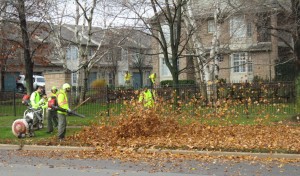 This crew will probably not be clearing the leaves from your property. A loose leaf collection service is provided to Burlington residents in the fall of each year. This program is in addition to the yard waste collection service provided by Halton Region.
Please follow the guidelines below to help ensure a timely and cost-effective leaf collection program:
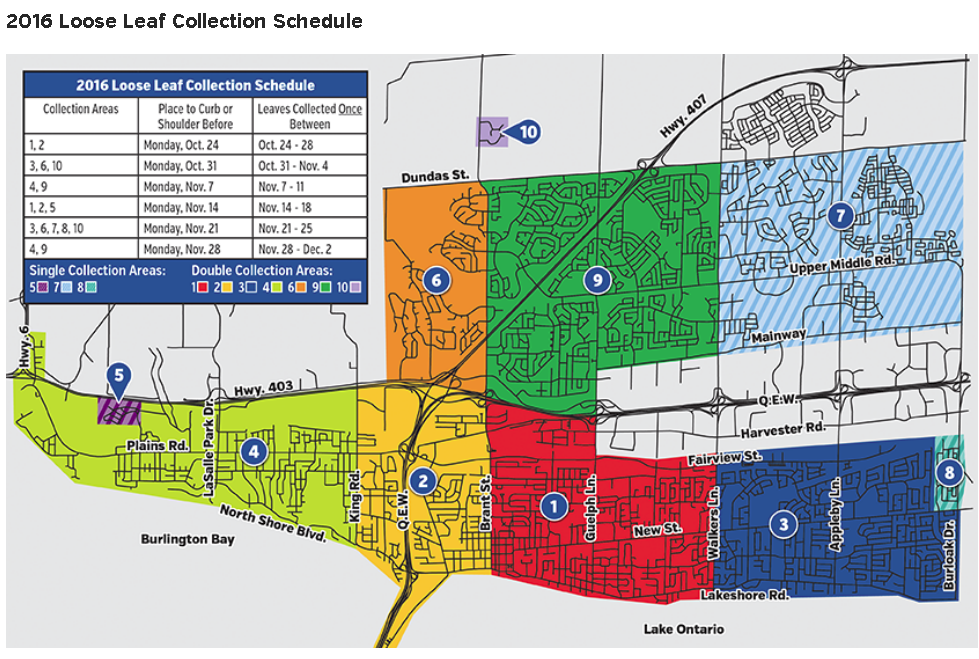 You can print this out and put it on the fridge. Have your loose leaves raked and ready for pickup just prior to the start date for your collection area.
Be mindful of collection dates and avoid raking leaves to the road too early.
Place leaves up to the edge of the curb or roadway (but not on the road) in a loose pile so city equipment can reach them.
Ensure loose leaves are not covering catch basins or in the ditches in front of your home.
Make sure leaves do not contain branches or other debris. Leaves mixed with other waste cannot be collected.
Avoid placing leaves on sidewalks and walkways.
Remove basketball nets, parked vehicles and other obstructions from the road to allow city crews clear access to leaf piles.
Do not place garbage bags, garbage bins, Blue Boxes or GreenCarts on top of loose-leaf piles.
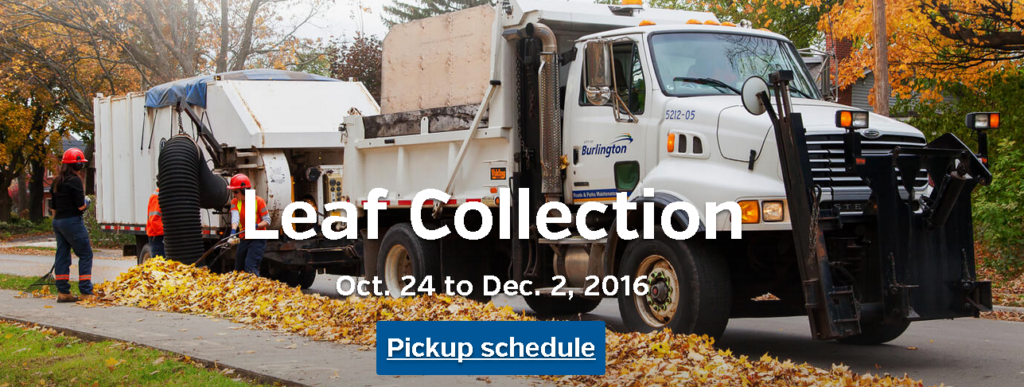

 By Staff By Staff
October 25th, 2016
BURLINGTON, ON
Local artist and newly appointed Co-President of the Burlington Fine Art Association, Vanessa Cress Lokos invites you to her exhibition, “Suspended.” Vanessa has a lengthy history with the Art Gallery of Burlington as a volunteer, staff and guild member.
The exhibit takes place October 29 – November 28, 2016; opening reception is Sunday November 6, 2:00 – 4:30 pm in the Fireside Lounge / 1333 Lakeshore Rd., Burlington, ON
 Suspended This body of work speaks to time and to all things suspended, literally and figuratively. Inspired by the diversity of landscape, it’s unnoticed details and the unexpected.
Primarily through the forgotten tradition of glaze oil painting, Vanessa explores luminous colour and depth. Whether derived from open air or first captured with a lens, these paintings compel the viewer to slow their pace and contemplate the beauty around us.
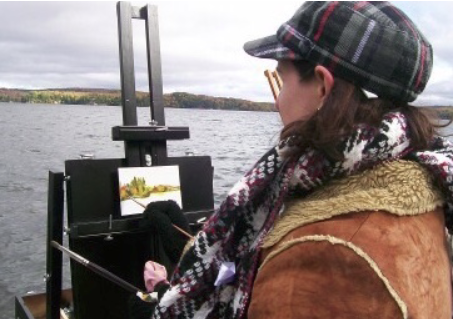 Vanessa Cress Lokos Vanessa Cress Lokos obtained a BA with a Concentration in Visual Arts from the University of Ottawa. Her travels led her through Europe and eventually to Melbourne, Australia, where she continued to study art, exhibited and sold her work. Vanessa has also exhibited in Georgetown, Mississauga, Toronto, Waterdown, and juried exhibitions in Burlington and Hamilton. Vanessa is a member of a variety of art organizations including the Burlington Fine Arts Association and the Canadian Glaze Oil Society.
An Honourable Mention was awarded to Vanessa and members of the BFAA for a collaborative work at the Art Gallery of Burlington. Her work has been accepted and sold at several AGB live Art Auctions.

 By Staff By Staff
October 25, 2016
BURLINGTON, ON
It is a violent world out there – for the most part the average person is protected from it.
The Members of the Halton Regional Police Service (HRPS) Provincial Anti-Violence Strategy (PAVIS) Team announced that they have arrested 17 individuals as a result of a multi-agency initiative involving six partner police services.
Over the past several weeks, the PAVIS Team has tracked down persons wanted for criminal offences in Ontario and other provinces, specifically Quebec. PAVIS Team officers compiled lists of wanted individuals, confirmed that warrants were still in good standing, and completed backgrounds on intended targets. The HRPS worked closely with the Service de Police de la Ville de Montreal (SVPM) and Crown Attorney’s Office to coordinate arrests of the wanted parties.
Southern Georgian Bay O.P.P., Ottawa Police Service, Service de Police de la Ville de Quebec (SVPQ), and Kingston Police Service assisted in the execution of this project. The HRPS also supported Hamilton Police Service with the return of a wanted party.
All told, eight offenders in Montreal and nine in Ontario were arrested as a result of a three day blitz, which ran from October 17 to 19. They face more than 45 charges, including Assault, Break and Enter, Fraud, Utter Threats to Cause Death, and Breach of Probation.
The project, and the resulting arrests, were made possible by a grant from the Ministry of Community Safety and Correctional Services and will be ongoing through the end of December, 2016.
Follows is a summary of the individuals arrested and associated charges.
Halton Regional Police Service warrants arrested by SVPM:
1. Janvier BETCHLEY (2013) – Theft of Motor Vehicle
2. Sylvain COALLIER (2010) – Break and Enter x 6 (also wanted in Ottawa for Break and Enter, Break and Enter Tools, and Breach of Probation)
3. Guy COALLIER (2010) – Break and Enter x 6 (also wanted in Kingston for Break and Enter, and Mischief Under $5000)
4. Chyan BOWEN (2015) – Unauthorized Use of Credit Card, Fraud Over $5000, Possess Counterfeit x 2, and Failure to Attend Court
5. Bernard THERRIEN (2016) – Unauthorized Use of Credit Card, Fraud Over $5000, Possess Counterfeit x 2, and Failure to Attend Court
6. Ashley JACOBS (2014) – Assault, Breach of Probation, Failure to Comply Undertaking, and Fail to Attend Court
7. Michael CRICK (2015) – Fail to Comply Probation, and Fail to Attend Court (Hamilton warrant)
8. Junior BELLAMY (2013) – Theft of Motor Vehicle
Montreal warrants arrested by Halton Regional Police Service:
1. Jean LAVEAU (1999) – Utter Threats to Cause Death
2. Michael McHENRY (1991) – Break and Enter Intent, Conspiracy to Commit Indictable Offence
3. Steven POLYNICE (2009) – Fraud, Credit Card Fraud, Breach of Probation, Obstruct, Breach of Recognizance, Utter Threats to Cause Death, and Outstanding Warrants x5
4. Cuong NGUYEN (2009) – Outstanding Warrant x1 (SVPM (2009) for Possession for the Purpose of Trafficking Cannabis, Production of Cannabis (Marihuana). Also faces charges in Guelph for Theft, Possession of Property Obtained by Crime x 2, and Possession Marihuana
5. Thi HOANG (2009) – Outstanding Warrant x1 (SVPM (2009) for Obstruct in relation to Cuong NGUYEN. Also faces charges in Guelph for Theft, Possession of Property Obtained by Crime x 2, and Possession of Marihuana
6. Paul ROARKE (2004) – Theft, Possession of Property Obtained by Crime, and Possess Break and Enter Tools
7. Richard SMITH (2013) – Obstruct Justice
8. Peter HONSBERGER (2003) – Credit Card Fraud, and Conspiracy to Commit Indictable Offence
9. Jonathan DIAS (2005/2006) – Possession of Property Obtained by Crime, Fraud, and a Committal Warrant
If anyone has information on wanted parties or parties who are breaching their conditions of their release, please call Crime Stoppers at 1-800-222-TIPS (8477) or text Tip201 to CRIMES (274637), or contact Sergeant Paul Harrower (Milton/Halton Hills) at 905-825-4747 ext. 2467, Detective Constable Tim Woollands (Oakville) at 905-825-4747 ext. 2208, and/or Sergeant Dwayne Perron (Burlington) at 905-825-4747 ext. 2387.
The Provincial Anti-Violence Intervention Strategy (PAVIS) is a multi-agency program run through the Ministry of Community Safety and Correctional Services. The Halton Regional Police Service (HRPS) has been participating in this program since 2007.
The most recent submission to the PAVIS program was initiated in 2016 and was approved by the Ministry later that year. The approved funding term concludes on December 31, 2016. The submission that was made and approved is built around the HRPS response to Community Safety Planning in Halton Region.
Strategies include increased resources for weekend/evening patrols of individuals who fail to comply with court-imposed conditions; ensuring compliance through increased checks; stakeholder collaboration with external partners for matters pertaining to the sentencing of offenders, and; additional resources to pursue arrest warrants.
During this funding term, the HRPS will continue partnering with stakeholders to increase organizational and community capacity to prevent and address recidivism through the application of risk-based interventions.
Take a closer look at the reasons for these people being arrested – they are serious offences.

 By Pepper Parr By Pepper Parr
October 25th, 2016
BURLINGTON, ON
Should the Halton District School Board trustees decide that the Lester B. Pearson High School should be closed and its students asked to attend M.M. Robinson instead that would bring to an end a school that was created for the community more than forty years ago when the idea of a community school was considered important.
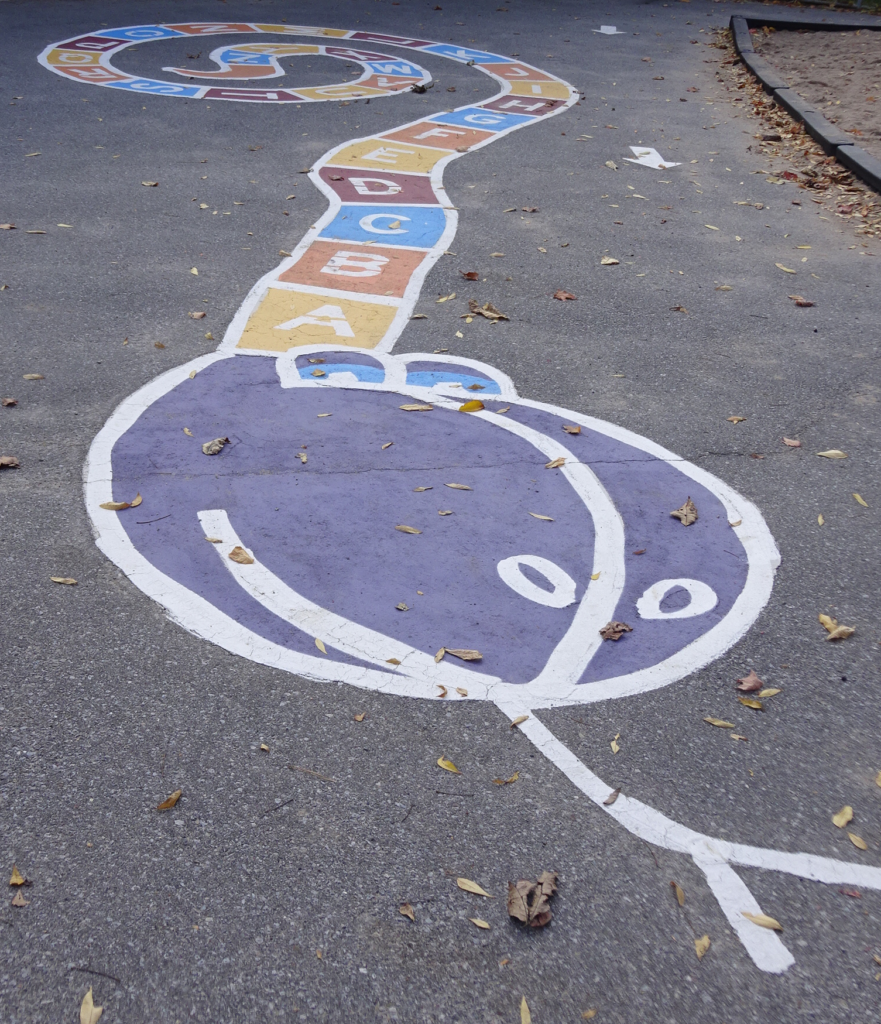 Great way to get an idea as to just what the alphabet is for the nursery set. The Pearson school was made even more unique when a Co-op nursery program was included. That nursery now provides classes for close to 100 children.
There are morning and afternoon sessions in a setting that will be very very hard to replicate.
Fiona Wielhouwer, with a certificate that is the equivalent to the Canadian Early Childhood Education that she earned in the United Kingdom, is the supervisor who reports to a nine parent volunteer board. That board may have a very serious and perhaps daunting task ahead of them.
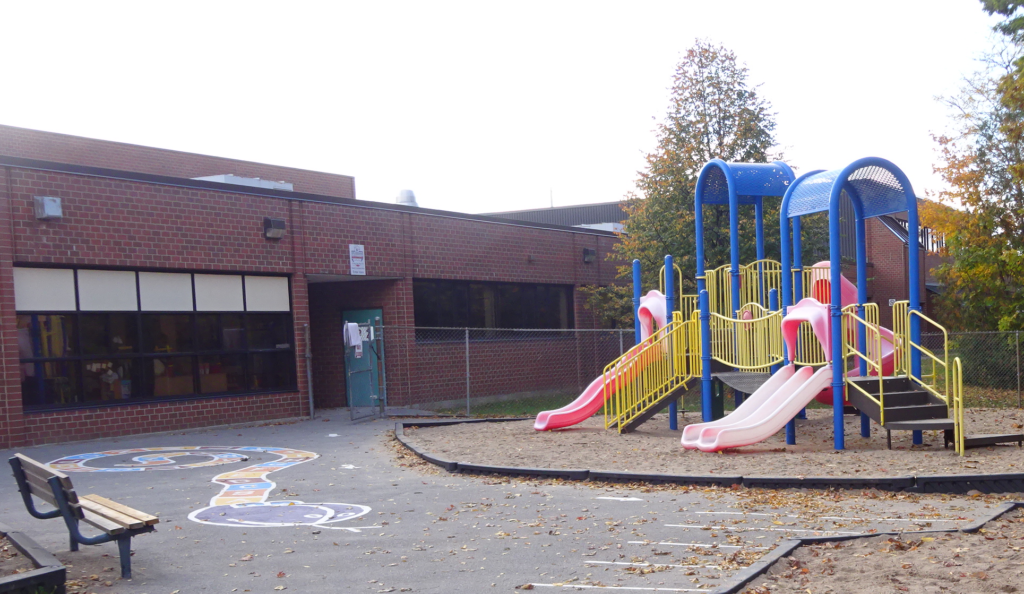 Tucked in at the very back of the high school the nursery has a seperate entrance and a secure well outfitted playground. The nursery co-op was planned as part of a school that would serve the wider community. A school the size of Pearson would normally have two gymnasiums – Pearson has three. The intention right from the beginning was to make the space available to everyone in the community.
The nursery serves as a student placement location for those who think they might want to work in the childhood care field. It is also affiliated with both Sheridan and Mohawk colleges where Early Childhood courses are given.
Fiona Wielhouwer explains that the nursery uses an enquiry based approach to the care they give the children. “We aren’t a drop and run location – we work with the parents and prepare the children for the JK and SK classes they will move on to – during their time with us the children get used to the idea of being away from Mommy for short periods of time and they learn to mix with other children.
The nursery interacts with the high school but administratively it is a separate organization. We do get help from the IT people in the high school and when we need something from the shop people they work with us.
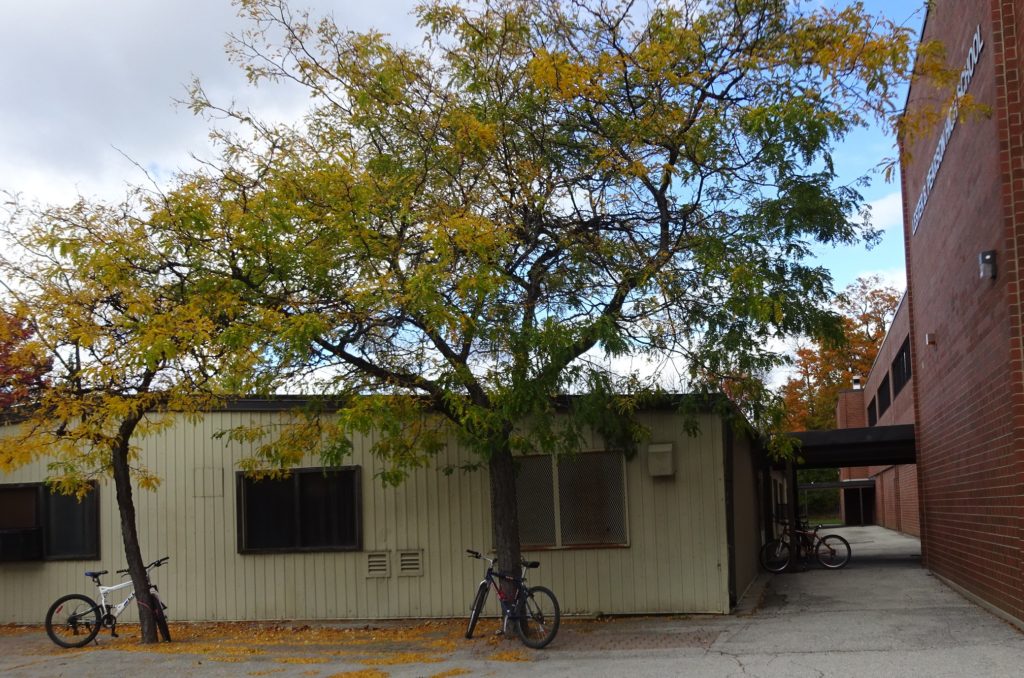 Portables that were once necessary are now empty – a sign of the enrollment decline. As a community school it works. Pearson was never intended as a large high school. When enrollment exceeded the capacity a bunch of portables were stuck at the front of the school – they are now empty.
When the school was created it was intended as a “lab” school – a place where different ideas would be tested. The co-op nursery in a school has worked out very well. Some of that original thinking seems to have been forgotten and now it is a matter of numbers.
There are now parents who have their children in the nursery – there was a time when they were in the nursery and then attended the high school.
The city is said to have invested some money in the school when it was built and the belief is that the Region supports the nursery financially.
There was a time when there were community clubs in the school – the place was a real community hub – that too seems to have been given up on.
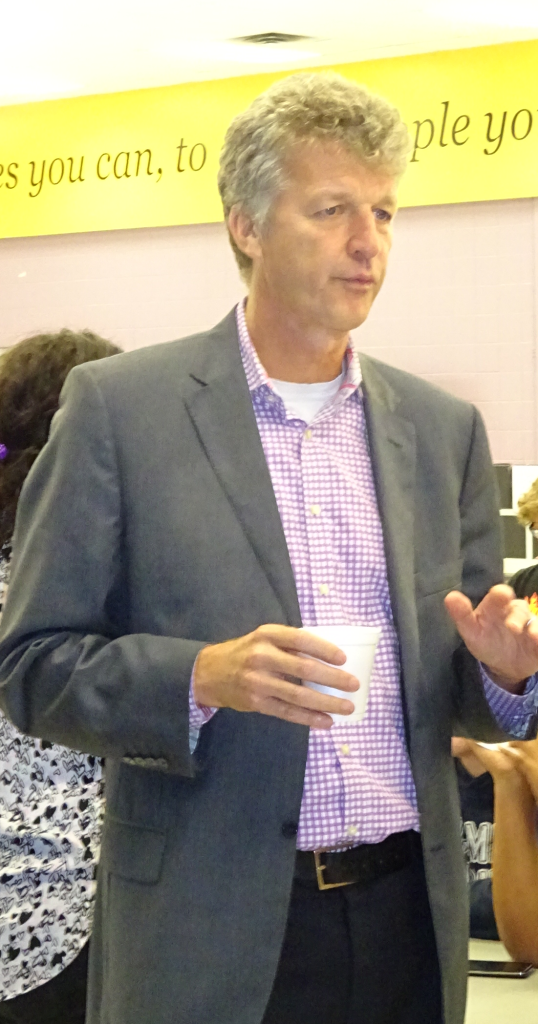 Current Director of Education for the HDSB, Stuart Miller was once the vice principal at Pearson. The school is now set out as the preferred option of the board staff for closing – the current Director of Education Stuart Miller was once the Vice principal at the school and he knows what kind of a school it is – however, his job requires him to initiate the process of determining if a school should be closed when it falls below 65% of its capacity utilization.
It is now up to the trustees to determine of the school should close – and it is up to the parents to inform the trustees as to what they want.
For the children – this week is all about pumpkins – especially the ghost pumkins.

 By Staff By Staff
October 25th, 2016
BURLINGTON, ON
More public art.
 The public art painted on the King Road grade separation a number of years ago was done by Judy Mayer-Grieve and was reasonably well accepted. A new program through Burlington Public Art – the Park Marker Program will be drawing on the success of the Burlington Mural Project, which commissions local artists to create murals.
Additional detail on the mural project has been added to the end of this article.
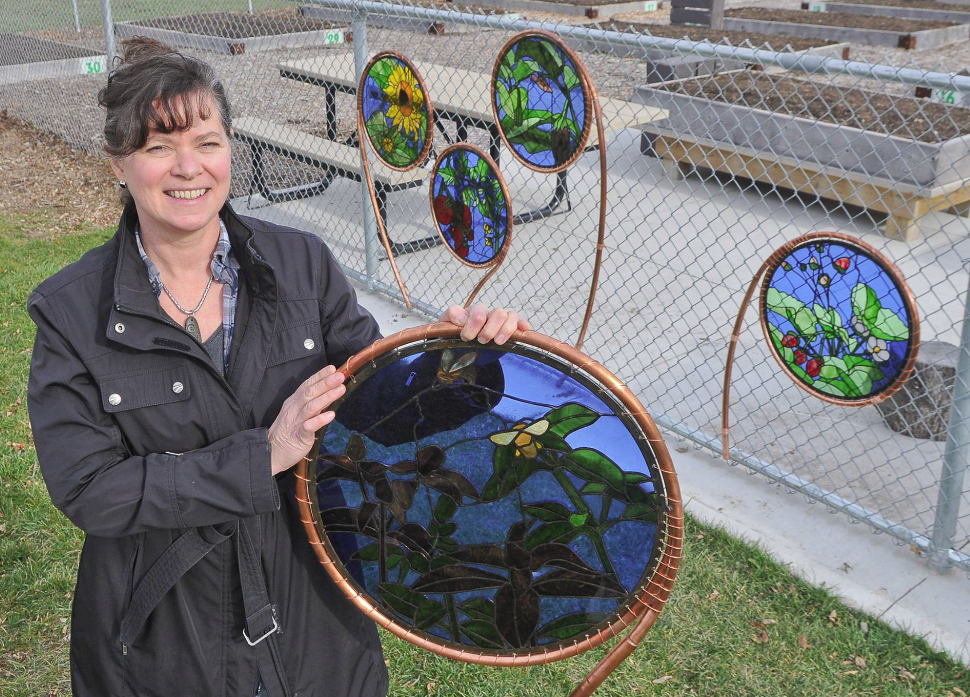 Teresa Seaton did the art work that is in Amherst Park park next to a community garden. The art has been tempered and will easily withstand the winter weather. The Park Marker Program will focus on public art sculpture.
This annual program will commission artists to create small-scale sculptures in neighbourhood parks throughout the city. These commissions are open exclusively to artists residing in Burlington, Ont. Applicants do not need previous public art and/or sculpture experience to apply to this program.
Applications are due Monday, December 12, 2016.
About the Park Marker Program
Applications for the 2016 program are now open! Please visit the Calls for Artists page to download the Request for Proposals and access the online application system.
There will be a workshop on Saturday, November 12, 2016, Time: 11:30 a.m. – 3:30 p.m. at the Central Library, Holland Room, 2331 New Street that will give you helpful insight into planning your project and preparing a great submission that will get you noticed by the jury.
The workshop will start with a brief overview of the Park Marker program and 2016/17 projects followed by a session led by artist Matthew Walker. Matthew will give helpful tips and tricks on preparing your submission and the steps you need to take to conceptualize your project. Following a brief break, public art fabricator Mike Bilyk will lead a session exploring material choices for outdoor sculpture and pointers on working with a fabricator.
This workshop is FREE and lunch will be provided. Please RSVP by Tuesday November 8th by visiting https://parkmarker.eventbrite.com
Workshop Facilitators
Matthew Walker: Matthew Walker is a Hamilton artist whose sculpture-based practice incorporates diverse technical approaches to object-making in public spaces. He has been involved in the production of public art in a range of capacities, including designing public calls, adjudication, receiving commissions, and engaging with other artists in the field as a technical mentor and advisor. For over a decades and a half, Matthew’s work as a facilitator has exposed him to a diversity of practices and conceptual approaches to art making that reflect the expansive experiences that are possible in the creation of public work.
During this workshop Matthew will provide insight into the processes behind the commissioning of artwork. How are calls for public art designed? How does the commissioning process take shape? What are some of the criteria that are considered when assessing a submission? Emerging artists seeking to enter the field of public art will find this discussion useful as they reflect on what approaches they may take in designing their work for public space, and, how to prepare an application.
Matthew’s current and previous work experiences includes being a member of The Town of Banff’s Public Art Committee, Supercrawl’s Curatorial Committee and as the Sculpture Facilitator at the Banff Centre’s international residency program. Matthew is currently working on a public commission for Artfarms in Buffalo, NY. You can look at what this artist does at – https://matthewwalkersculpture.carbonmade.com
Mike Bilyk is the President of Lafontaine Ironwerks, a custom metal fabrication and installation company located in Tiny, Ontario. Over the past 16 years, Lafontaine Ironwerks have developed a unique specialty in working with artists to develop and deliver complex public art projects. Mike and his team have worked with numerous internationally renowned artists including: Douglas Coupland, Michel DeBroin, John McEwan and Vito Acconci. Lafontaine Ironwerks works closely with artists from concept through to finished product to ensure the utmost in quality, efficiency, and cost-effectiveness.
For this workshop, Mike will give workshop participants a behind-the-scenes look into some of the large-scale projects produced by Lafontaine Ironwerks. Mike will also cover material choices and installation techniques for outdoor public art sculpture as well as helpful tips and tricks to consider when working with a fabricator.
https://www.liwi.ca
One-on-one Application Review Sessions: November 30, 2016, Times: 1 to 4 p.m. and 5 to 7 p.m.*
Location: Burlington City Hall (426 Brant St.)
Artists preparing a submission to the Park Marker program may book a 30-minute session with the Public Art Manager to review a draft of their application package and get constructive feedback.
Attendance is optional and appointments must be booked in advance. To book an appointment please contact: Kim Selman, kim@cobaltconnects.ca or 905-548-0111
The first round of public art was a collection of paintings in public places. The city’s public art adviser ran a juried competition and the following six people were selected:
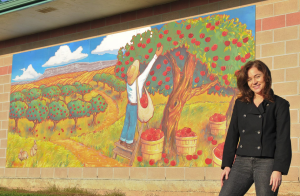 Tamara Kwapich did the mural in Orchard Community Park; once the location for some of the best apple orchards in the province. • Judy Mayer-Grieve: King Road Underpass, Ward 1
• Claire Hall: Freeman Station, Ward 2
• Teresa Seaton: Amherst Park, Ward 3
• Hannah Sell and Liam Racine: Port Nelson Park, Ward 4
• Tamara Kwapich: Orchard Community Park, Ward 5
• Donna Grandin: Ireland Park, Ward 6
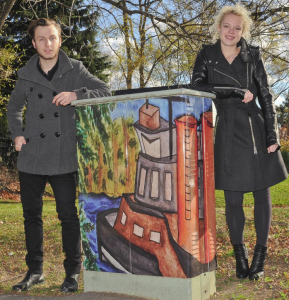 Hannah Sell and Liam Racine did the art work that is located in the small Port Nelson Park where it will be seen by thousands. There was a time when tonnes of timber was shipped from a wharf at the foot of the park. 
 By Staff By Staff
October 25th, 2016
BURLINGTON, ON
We ran a piece a number of weeks ago about the high number of traffic tickets handed out in the Waterdown Road part of the city. The reaction from our readers was interesting.
The work the police are doing isn’t going to end – Halton Regional Police officers from 30 Division have been running two traffic initiatives across the City of Burlington throughout 2016.
 Operation RISC (Reducing Intersection Safety Concerns) has been in effect since 2015 by officers from 30 Division, in order to maximize police visibility and increase the public’s perception of safety while driving. Operation RISC (Reducing Intersection Safety Concerns) has been in effect since 2015 by officers from 30 Division, in order to maximize police visibility and increase the public’s perception of safety while driving.
Collisions at intersections have a high risk potential of serious injuries or even death, making intersection safety a priority for the Halton Regional Police. The most common contributing factors are inattentiveness, distracted driving (cell phone use), failing to yield, driving too fast for road conditions, following too closely and disobeying traffic light signals.
The Halton Regional Police have also continued the Residential Traffic/Stop Sign/Speeding (RTSS) Initiative in order to deliver a clear message to drivers that our residential roads are not raceways. This traffic safety initiative was designed to increase compliance of stop signs. Police have utilized education and enforcement strategies throughout 2016 in order to reduce the speeds of vehicles travelling on residential roadways and to promote safer driving habits.
During the first 9 months of 2016, officers in Burlington conducted 8,137 traffic stops, issued 7,937 Provincial Offences Notices and handed out more than 400 warnings to drivers. Furthermore, Halton Police spent a total of 3,167 hours dedicated to these 2 initiatives throughout Burlington.
Police will continue to focus their efforts on intersections that pose a higher risk to the public based on past collision analytic data. “Accidents can be prevented if all drivers slowed down and were less distracted behind the wheel,” said Sgt. Jared McLeod, District Response Unit.
Halton Regional Police is committed to reducing motor vehicle collisions in an effort to provide a safer community. Halton Regional Police is further committed to reducing dangerous and aggressive driving behaviours that put all road users at risk. Operation RISC and Residential Traffic/Stop Sign/Speeding (RTSS) will continue throughout the City of Burlington.
If any citizen would like to report a traffic concern they can do so by visiting the HRPS website and submitting an online traffic complaint:
https://www.haltonpolice.ca/services/reporting/trafficcomplaints.php

 By Pepper Parr By Pepper Parr
October 25th, 2016
BURLINGTON, ON
There is an Ontario Arts Council workshop where valuable guidance on applying to the OAC’s Visual Artists grants program for individual artists is available. They can answer any questions you may have about applying for funding.
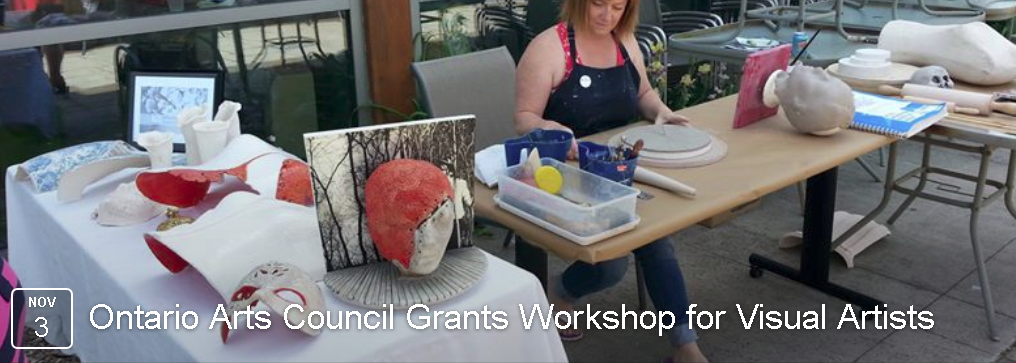 Taking place at Hamilton Artists Inc., 155 James Street North, Hamilton, Ontario. Attendance is free but registration in advance is requested by Wednesday November 2 at 5:00pm. Taking place at Hamilton Artists Inc., 155 James Street North, Hamilton, Ontario. Attendance is free but registration in advance is requested by Wednesday November 2 at 5:00pm.
It is being put on by the Hamilton Arts Council Visual Arts Committee – no reason why someone from Burlington can’t attend.
There is also the November 22 deadline of the Visual Artists: Emerging program is one of the few OAC programs selected as a pilot for a new online grant application system. This session will highlight some of the changes artists will see online, and provide some information on further Visual Arts program updates coming up in 2017.
To learn more about these upcoming changes, visit https://www.arts.on.ca/Page6375.aspx
Attendance is free but registration in advance is requested by Wednesday November 2 at 5:00pm.

 By Don Graves By Don Graves
October 26, 2016
BURLINGTON, ON
I’ve been painting landscapes for the past 20 years. Prior to that I served as the Dean of Art at Sheridan College and later as the Dean of Art and Business at George Brown College. Incongruous as that sounds, art is a business and business certainly includes art.
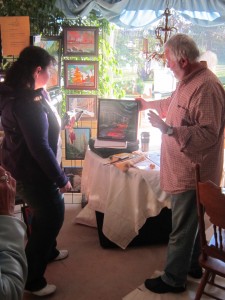 Don Graves – showing a piece of art to a potential client – they bought. My quick guide to buying art: if you see something that draws you in, something that ‘speaks to you’, a piece that has triggered your imagination… then you’re establishing a relationship with an artist and their work. I buy art from the person who created it. This isn’t full proof, it just works for me.
Where can you see and purchase fine art and fine craft?
• An art gallery. Big, small, located in major urban centres, nestled in seasonal tourist locations.
• The artist’s home studio and website. And the new variation, the gallery-studio.
• The auction—big time, fast paced, frenzied six-seven figure bidding down to small local silent auctions for good cause fund raising.
• The local art show-tour: one of the best, informal sources for art in homes or offices.
I’ve done all of the above and here’s why the local art show and local studio tour is my go-to choice.
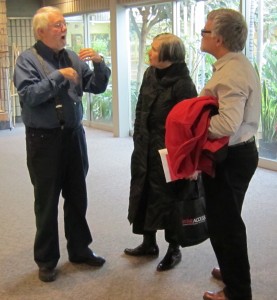 Don Graves – expounding on what art is all about. Understanding the business of buying art.
1. Artist cost: rent, paint, frames, brushes, website… and commission that can reach 50% and higher. (For an artist to recover $500.00, a gallery price hits at least $1000.00). Art shows and studio tours charge a contained rental fee. Like most artists, I want to see my work on your walls and art shows make that affordable for the artist and the buyer.
2. I want to meet you, talk about art, listen to you, and perhaps even paint. An informal atmosphere, with a coffee, is ideal.
3. What is art worth? Such a loaded word…worth. In the final analysis it is worth what someone will pay for it. A local show-tour offers the most purchase flexibility: prices with no jumbo-sized commissions, a reasonable price with payment terms.
4. “Damn, it’s sold. Look for it…and act.” The art show is an ideal place for that. I’m not suggesting buy in haste, repent at leisure. I am saying, buying art is based on what moves you, captures your imagination. A buyer needs to listen to their soul and act. I’ve had one buyer in 3 years come back to me saying they’d made a mistake. Do I want a painting on a wall where it is not wanted? I know few artists who do. I took the painting back and the buyer chose another piece.
The Burlington Studio tour is a unique opportunity. A studio tour is a rare opportunity to glimpse inside a working studio, a bit like my second choice on where to buy. You are where the action is, be it wood turning, painting, stained glass, jewellery, pottery. All fine art and fine craft, individually designed and created.
The 2016 Art in Action tour takes place November 5th and 6th.
 A collection of Graves’ art displayed in the Fireside Room at the Art Gallery of Burlington. Burlington is home to two exciting variations on this theme. Teresa Seaton’s Stained Glass studio and gallery and Gallery 2, with painters Anne Moore, Cheryl Goldring and Don Graves plus guests. The art of creation open to you…from inspiration, design, sketch, create to sell.
A closing thought; An art show-tour is a mix and mingle recipe. Couples, families, artists, location, fresh air, funky food…something special happens.

|
|
 By Ray Rivers
By Ray Rivers
































 Why do we need a “PAR” process?
Why do we need a “PAR” process? However, as the Director of Education, I need to ensure all Burlington high school students have equitable access to programs that allow them to explore and enhance their true potential. The PAR process will look at this issue and investigate various options to address the challenge that many Burlington high school students are experiencing.
However, as the Director of Education, I need to ensure all Burlington high school students have equitable access to programs that allow them to explore and enhance their true potential. The PAR process will look at this issue and investigate various options to address the challenge that many Burlington high school students are experiencing.



 “The elderly victim was found living in deplorable conditions. This was an excellent example of team work and collaboration between the internal resources of the police service and external partners. The Halton Regional Police Community Mobilization Bureau and Criminal Investigations Bureau, Seniors Liaison Team along with Halton Paramedic Services and the Community Care Access Centre worked together in bringing this investigation to a successful conclusion,” said Detective Sergeant Dave Costantini. “More importantly, because of this collaboration a vulnerable member of our community has been rescued from unthinkable conditions and I am happy to report she is expected to make a full recovery.”
“The elderly victim was found living in deplorable conditions. This was an excellent example of team work and collaboration between the internal resources of the police service and external partners. The Halton Regional Police Community Mobilization Bureau and Criminal Investigations Bureau, Seniors Liaison Team along with Halton Paramedic Services and the Community Care Access Centre worked together in bringing this investigation to a successful conclusion,” said Detective Sergeant Dave Costantini. “More importantly, because of this collaboration a vulnerable member of our community has been rescued from unthinkable conditions and I am happy to report she is expected to make a full recovery.”







 Royal Botanical Gardens’ Nature Sanctuaries protect over 900 hectares of woodlands and wetlands. They are an important stopover for migratory birds and a biodiversity hotspot. The health and sustainability of our Nature Sanctuaries is being threatened by non-native, invasive species.
Royal Botanical Gardens’ Nature Sanctuaries protect over 900 hectares of woodlands and wetlands. They are an important stopover for migratory birds and a biodiversity hotspot. The health and sustainability of our Nature Sanctuaries is being threatened by non-native, invasive species.

















 Operation RISC (Reducing Intersection Safety Concerns) has been in effect since 2015 by officers from 30 Division, in order to maximize police visibility and increase the public’s perception of safety while driving.
Operation RISC (Reducing Intersection Safety Concerns) has been in effect since 2015 by officers from 30 Division, in order to maximize police visibility and increase the public’s perception of safety while driving.
 Taking place at Hamilton Artists Inc., 155 James Street North, Hamilton, Ontario. Attendance is free but registration in advance is requested by Wednesday November 2 at 5:00pm.
Taking place at Hamilton Artists Inc., 155 James Street North, Hamilton, Ontario. Attendance is free but registration in advance is requested by Wednesday November 2 at 5:00pm.








